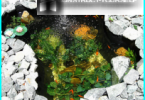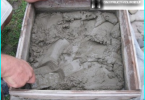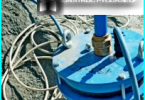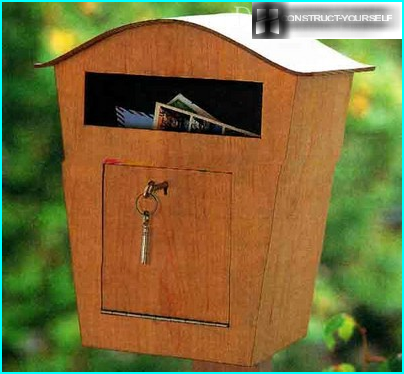
In the private sector, located in the city, it is usually possible to lead the water from the centralized network. However, in settlements where there is no pipeline, it is necessary to equip the Autonomous system from hydraulic structures in the areas. However, sometimes this need arises when access to the Central network. This happens if in the summer you need to water a large area, and water bills are too high. In such cases, the cost one time to construct a well. How to bring water to the house from the well or wells?
The contents
The components of the water system
In order to organize uninterrupted supply of water to the points of demand and to provide the desired pressure, the supply plan should include the following elements:
- hydraulic structure;
- pumping equipment;
- accumulator;
- the water treatment system;
- automation: manometers, sensors;
- tubing;
- stop valves;
- collectors (if necessary);
- consumers.
You may also need additional equipment: water heaters, irrigation, irrigation systems, etc.
Features choice of pumping equipment
For stationary water systems often choose submersible centrifugal pumps. They are placed in the wells and in wells. If the hydraulic structure of small depth (9-10 m), it is possible to acquire the surface equipment or pumping station. It makes sense, if the casing pipe bore is too narrow and there are difficulties with the choice of the submersible pump to the desired diameter. Then lowered into the borehole only of the intake hose, and the unit installed in the caisson or utility room.
Pumping stations have their advantages. This is a multifunctional system pump, automatic controls and accumulator. Although the cost of the station is higher than the submersible pump, the ultimate system is cheaper because it eliminates the need to separately purchase tank.
Of the downsides of pumping stations the most significant is the strong noise and limits the depth with which they are able to raise water. It is important to install the equipment. If the pump station to make mistakes, it can «to zavozdushivanie», what affects the stability of water supply.

For the smooth operation of the water system, in addition to the pump, install the hydraulic tanks and units of automatic control
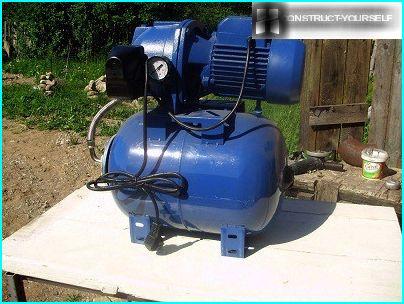
When selecting a pumping station to properly calculate the necessary power, performance, and buy equipment with high efficiency
There are instances when installing a submersible pump is simply impossible and you have to mount surface or a pumping station. For example, if the water level in the well or wells is insufficient to comply with the rules of installation of deep equipment.
The pump should be set so that above it was a layer of water less than 1 m, while the bottom remained 2-6 m. This is necessary for good cooling of the motor and the intake of clean water without sand and silt. Failure to comply with installation conditions will lead to rapid wear of the pump due to the pumping of contaminated water or burnout of the windings of the motor.
When choosing a submersible pump for the well, you need to pay attention to the type of construction of the device. If you have installed a three-inch pipe operating, many owners wells buy cheap and reliable domestic pump «Baby». The diameter of its housing allows you to mount the device even in a narrow pipe. However, with all the advantages «Baby» — the worst choice. This equipment is the vibrating type.
The constant vibration of the engine quite quickly destroys the casing string. Savings at the pump may result in much greater spending on drilling new wells or replacement of casing that the cost and complexity comparable to the construction of waterworks. Vibrating pumps are not suitable for narrow wells due to the features of the device and principle of work. It is better to put a pumping station.
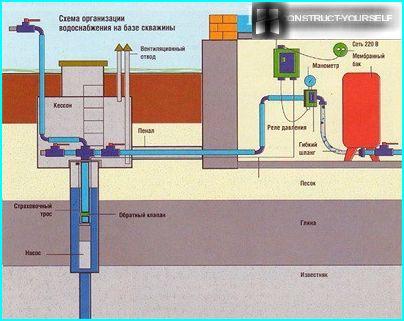
In the borehole deep pump is lowered on a safety rope. If you want to dismantle it, raising also follows the rope and in no case do not pull water-lifting pipe
Accumulator – a guarantee of uninterrupted supply of water
The presence of hydroaccumulating tank in the water system prevents many problems with water supply to the house. It is a kind of analogue of the water tower. Thanks to the hydraulic tank, the pump runs with less stress. When the reservoir is filled, the controller deactivates the pump and once the water level drops to a certain level.
Volume of hydraulic tank can be anything from 12 to 500 L. This allows us to provide a supply of water in case of a power outage. When calculating the volume of the accumulator consider that, on average, to ensure the water needs of a single person needs about 50 liters Daily from every stand-point taken about 20 liters of water Consumption for irrigation to be calculated separately.
There are two types of accumulators – diaphragm and cumulative. The former are usually of small volume, equipped with pressure gauge and control valve. The objective of the hydraulic tank is to provide sufficient pressure in the water main. Storage tanks are much larger. Filled, they can weigh up to a ton.
Bulk containers are mounted on the upper side, therefore, the design of the water supply system it is necessary to foresee the need to reinforce building structures and to consider insulation for the winter. The volume of water in the storage tank is sufficient to power outages water enough for at least a day.
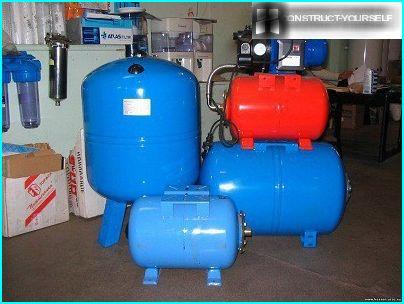
There are many designs of accumulators. Depending on the location, you can choose vertical or horizontal model
HDPE pipes – a simple and reliable solution
In the sale you can still find water pipes of any material – steel, copper, plastic, metal. More and more owners of country houses prefer HDPE pipe (polyethylene of low pressure). They are not inferior in quality metal, it does not Esmeralda, not burst, no rust, no rot.
High quality HDPE pipe is able to serve up to half a century. Due to low weight, uniform connecting and fastening elements are relatively easy to install. For an Autonomous water supply system is perfect, and every year more and more home owners choose it. Usually for plumbing buy pipes with a diameter of 25 or 32 mm.
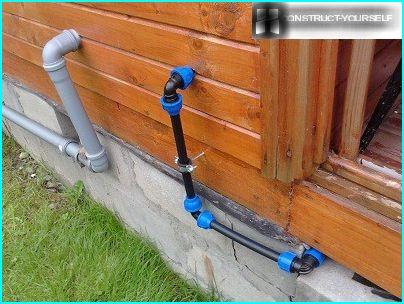
Polyethylene elastic. It stretches and shrinks depending on the ambient temperature. Because of this, he retains the strength, integrity and original shape
Strip the outer part of the pipe
During the construction of the water supply necessary to ensure the connection of the pipeline to lift the pipe below the level of soil freezing. The optimal variant of connection of wells through the installation of pitless adapter.
This simple and cheap device designed specifically for the withdrawal of pipes from the production casing of the well. How to equip the well with a pitless adapter, explained in detail on video:
If for some reason you cannot connect through the adapter, will have to build a sump or mount the caisson. In any case, the connection to the pipeline must be at a depth of at least 1-1.5 m. If the source is used well, at its base need to punch a hole for inserting the tube. Later, when all work on the laying of pipes will be completed, input seal.
Next scheme is about the same, for well that well. For the pipeline trench is prepared from hydraulic structures to the walls of the house. Depth of 30-50 cm below freezing. It is desirable to provide a gradient of 0.15 m to 1 m length.
When the trench is dug, its bottom is filled with a layer of sand, 7-10 cm, and then poured, tamped. On a sandy pillow the pipes are laid, connecting, conducting hydraulic test at a pressure 1.5 times exceeds the planned working.
If everything is in order, the pipeline is covered with a layer of sand 10 cm and tamped without excessive pressure so as not to break the pipe. Then fill trench with soil. Together with the pipe stack pump cable, isolated. If necessary, it is increasing if standard length is not enough to connect to a power source. Standard electric cable of the pump is 40 m.
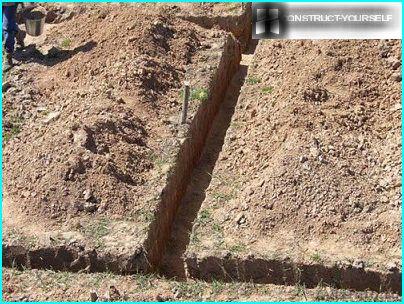
In the preparation of the trench be sure to equip a sandy pillow. It is necessary that the sharp cobblestones of the soil is not broken and does not depressurized pipe
How else can you bring water to the house? If the house is located in severe climatic conditions or the owner decided to build a pipeline so as not to depend on the depth of soil freezing, you have options of arrangement of external water supply system:
- The pipeline is laid at a depth of 60 cm and covered with 20-30 cm layer of a mixture of insulation – expanded clay, foam chips or coal slag. The basic requirements for the insulator – minimal water absorption, strength, no seal after ramming.
- It is possible to arrange external water supply at shallow depth is 30 cm, if you insulate the pipe with special insulation and corrugated casing.
- Sometimes pipes are laid with the heating cable. It’s a great way to localities where the winters are savage frosts.
The video presents the installation manual of the outdoor water:
The pipeline is in the house
Conduct water from the well into the house through the Foundation. The pipeline often freezes exactly at the point of introduction, even if it runs all the rules. Concrete is pervious to moisture and this contributes to problems with pipes. To avoid them, the necessary length of pipe of a larger diameter than the water.
It will serve as a sort of protective sheath of the insertion site. It is possible to select a pipe from any available material – asbestos, metal or plastic. Importantly, the diameter was substantially larger, because the need to lay a water pipe with insulating materials. For water 32 cm we take the tube-case of 50 cm.
The pipeline is insulated, investing in a protective structure, then do the gasket, to achieve maximum waterproofing. Score in the middle of the rope, and from there to the edge of the Foundation – clay diluted with water to the consistency of thick cream. This is a great natural gidroizolyator. If you do not want to cook the mixture, you can use foam or any suitable sealant.
The pipeline must be located in the Foundation, not under it, because once it fills you can’t touch the ground under construction. Similarly, through the Foundation and enter the sewer line. Between the inputs of water and sewage should not be less than 1.5 m.
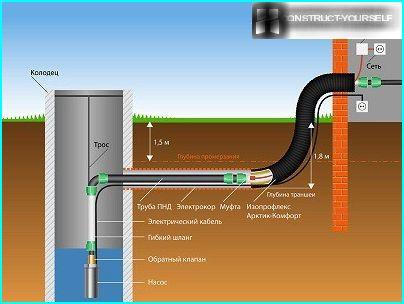
For insulation use a material with a thickness of about 9 mm. This protects the pipe from deformation shrinkage
Internal piping for water supply
Having had the water in a private house, you need to choose the schema and the type of internal wiring. It can be open or closed. The first method assumes that all the pipes are in sight. It is convenient from the point of view of repair and service, but from the point of view of aesthetics is not the best option.
Enclosed piping is a way of their placement in the floor and walls. The communication is completely masked, they are not visible under the fine finish, however, is time-consuming and costly process. If I have to repair the pipe, and all the room where you need access to them, too, will require the upgrade finishes.
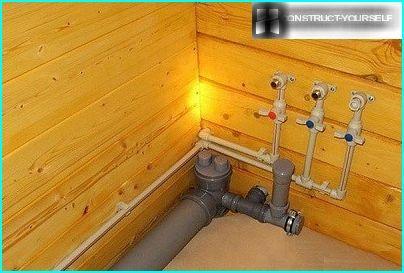
Most often used an open method of piping the domestic water supply. It is much cheaper and easier than chasing walls, to hide communications. Pipes made of polymer materials look good for an open system be better than metal
There are such wiremap:
- collector;
- tee;
- combined.
When the collector type wiring install manifold (fits). From going it is a separate pipe to each plumbing appliance. This option is wiring suitable for both types of piping – open and closed.
Due to the presence of manifold pressure in the system stable, but it is costly because it requires a large number of materials. A significant advantage of this scheme lies in the fact that the repair of one sanitary appliance water others maybe in the same mode.
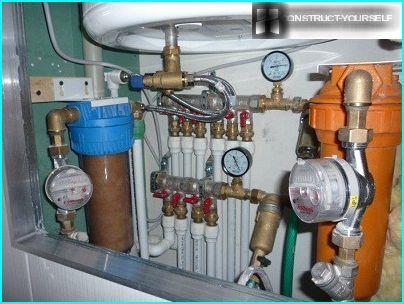
Installation of collector wiring is significantly more expensive tee, but these expenses pay off. Leaks often occur at joints. When the reservoir scheme of the joints at least
The tee scheme is called consistent. Sanitary appliances are connected one after the other. The advantage of this method is in its low cost and simplicity, but the disadvantage is loss of pressure. If several devices are operated simultaneously, the pressure decreases significantly.
When repairing at one point we have to turn off the entire water supply system. Combined scheme provides a collector connection of faucets and consistent – plumbing fixtures.
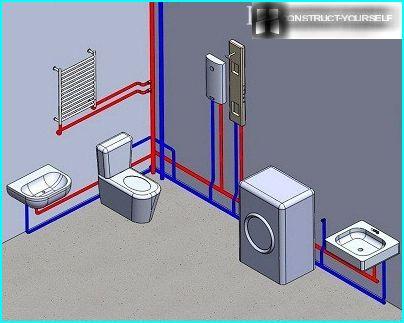
The serial connection of plumbing fixtures – the cheapest and most convenient option. However, this scheme may lead to the fact that when you open the cold tap in the kitchen in the bathroom will dramatically increase the water temperature
In most cases, for the internal water pipe choose pipe from polymer materials. They are easier to install than metal, plus there is no need to pay for the work of welders. The only caveat: to connect the toilet to the system it is desirable to use metal because plastic pipes do not always cope with the rapid changes in pressure. We also recommend you to read about the features of the piping in the bathroom on the website «Wannabedie«.
If necessary, drain the water from the system, install a separate tap. When internal plumbing is fully assembled, it is checked. If there are no leaks, the pressure in all points of demand are normal, the system can be put into operation.
Video example of arrangement of the plumbing inside the house:
When designing systems of Autonomous water supply should take into account the need for installation of filters and water treatment systems. They can differ significantly by function, type of construction and connected to the water supply. To choose the right filters, you need to do a water analysis, to determine whether there are undesirable impurities. If the chemical and microbiological analyses of the water right is only a rough purification of water from sand, silt and mud. If not – pick the equipment best after consultations with specialists.




